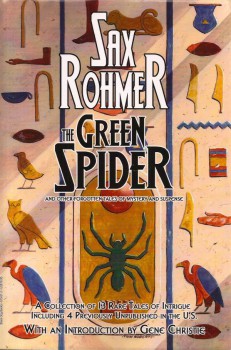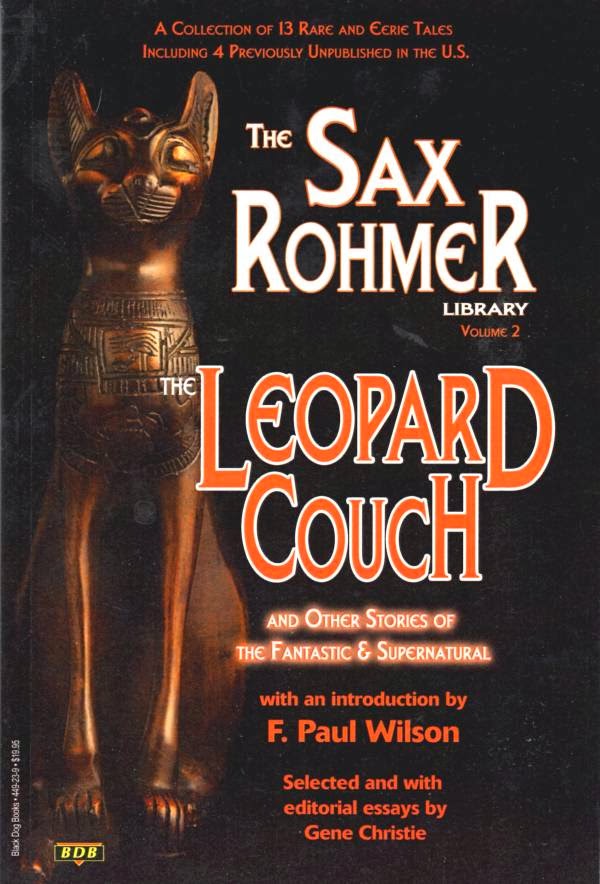Blogging Sax Rohmer… In the Beginning, Part Five

 “The Secret of Holm Peel” was first published in Cassell’s in December 1912 and was the last story Arthur Henry Ward published under the byline of Sarsfield Ward (having dropped the first initial A.).
“The Secret of Holm Peel” was first published in Cassell’s in December 1912 and was the last story Arthur Henry Ward published under the byline of Sarsfield Ward (having dropped the first initial A.).
Rohmer scholar Robert E. Briney rescued it from obscurity for the 1970 Ace paperback Rohmer collection of the same name. Many years later, Gene Christie selected the story for inclusion in the first volume of Black Dog Books’ Sax Rohmer Library, The Green Spider and Other Forgotten Tales of Mystery and Suspense, in 2011.
The story’s inspiration can be found in Rohmer’s article, “The Phantom Hound of Holm Peel,” which was first published in Empire News in February 1938 and was later collected by Rohmer scholars Dr. Lawrence Knapp and John Robert Colombo in the 2012 Battered Silicon Dispatch Box collection of Rohmer’s articles, Pipe Dreams: Occasional Writings of Sax Rohmer. The article was also recounted by Rohmer’s widow, Elizabeth Sax Rohmer, and his former assistant, Cay Van Ash, in their 1972 biography of the author, Master of Villainy, as well as by the aforementioned John Robert Colombo in his 2014 collection, A Rohmer Miscellany.
The story itself is a well-written Gothic romance set on the Isle of Man at the estate of Holm Peel. Rohmer brews a delightful concoction of past life obsession, a ghostly hound, the curse of a suicide, family drama, and a daring jewel heist. The trouble is the jarring changes in narrative voice give the story an awkward and, at times, amateurish feel that undermines the strength of the otherwise polished narrative.

 “A House Possessed” was first published in The New Magazine in December 1912. It was subsequently collected, along with a number of other rare Rohmer stories, in Volume 41 of the extremely rare British paperback digest series Lloyd’s Home Novels, The 10:30 Folkestone Express, where it was re-titled, “A Christmas Mystery.” The story remained out of print for nearly 50 years until Dr. Briney selected it for inclusion in the previously mentioned Ace paperback collection, The Secret of Holm Peel, which was published in 1970. Dr. Briney subsequently included it in the 1973 British hardcover collection, The Wrath of Fu Manchu and Other New Stories, first published by Tom Stacey, with a U.S. paperback edition from Zebra Books following in 1976. Peter Haining included the story in the 1995 anthology, Great Irish Tales of Horror. Finally, Rohmer scholar Gene Christie included it in the second volume of Black Dog Books’ Sax Rohmer Library, The Leopard Couch and Other Stories of the Fantastic and Supernatural, in 2012.
“A House Possessed” was first published in The New Magazine in December 1912. It was subsequently collected, along with a number of other rare Rohmer stories, in Volume 41 of the extremely rare British paperback digest series Lloyd’s Home Novels, The 10:30 Folkestone Express, where it was re-titled, “A Christmas Mystery.” The story remained out of print for nearly 50 years until Dr. Briney selected it for inclusion in the previously mentioned Ace paperback collection, The Secret of Holm Peel, which was published in 1970. Dr. Briney subsequently included it in the 1973 British hardcover collection, The Wrath of Fu Manchu and Other New Stories, first published by Tom Stacey, with a U.S. paperback edition from Zebra Books following in 1976. Peter Haining included the story in the 1995 anthology, Great Irish Tales of Horror. Finally, Rohmer scholar Gene Christie included it in the second volume of Black Dog Books’ Sax Rohmer Library, The Leopard Couch and Other Stories of the Fantastic and Supernatural, in 2012.
“A House Possessed” is the first weird fiction story credited to the pen name of Sax Rohmer. A chilling horror story set at Devereux Hall over Christmas, where a party of British and American revelers have gathered for the holidays only to find themselves terrorized by the Satanic figure of Count de Stano, a mesmerist and shape-shifter, who is also an ageless disciple of Nostradamus. The black magician’s touch causes others’ flesh to blister and reduces the falling snow to steam. The Count is the first of Rohmer’s larger than life villains. He escapes the church authorities at the story’s conclusion by transforming himself into an owl and fleeing the dawn of Christmas morning. Despite its excellence, there is a rushed quality to the story that suggests likely editing for word count. While it would have benefited greatly from expanding the narrative, the story is still quite impressive.
“A Deal in Wheat” remains one of the rarest of Rohmer’s works. Published just as the first Fu Manchu serial finished its run in The Story-Teller, it first appeared in Weekly Tale-Teller in June 1913 and has only been reprinted once in the aforementioned Lloyd’s Home Novels no. 41, The 10:30 Folkestone Express. The story is, uncharacteristically, a western set in the plains beneath the Andes and involves rival land barons. The villain’s plot is to make himself a fortune by releasing a plague of killer ants that will ravage his neighbor’s crops and overrun the surrounding area. It reads much closer to one of Sapper’s Jim Maitland yarns that followed a decade later than it does the author’s usual fiction. This curiosity is of greater interest for its scarcity than for any redeeming literary excellence. Nonetheless, Sax Rohmer had arrived by the Summer 1913 and would continue to prove a force in the publishing world for the next 35 years.
William Patrick Maynard was authorized to continue Sax Rohmer’s Fu Manchu thrillers beginning with The Terror of Fu Manchu (2009; Black Coat Press) and The Destiny of Fu Manchu (2012; Black Coat Press). The Triumph of Fu Manchu is coming soon from Black Coat Press.
This is a most cool series, Bill.
I very much enjoy the backgrounds to these stories and appreciate the amount of research that went into them. Long may they continue. JRC